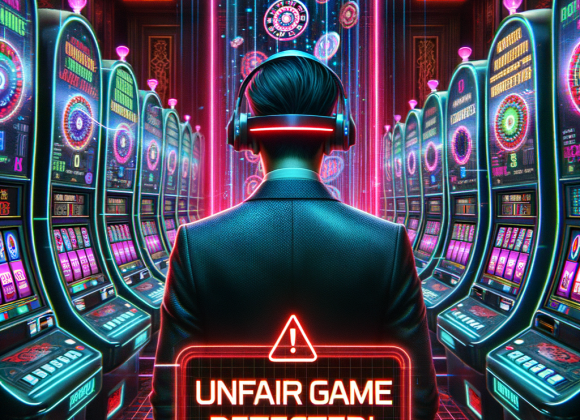The Great Game Logic Showdown: Server vs. Client!
In the dazzling world of gaming, the battle between server-side and client-side logic unfolds like a thrilling epic saga. Imagine it as a duel of wits between two formidable opponents, each vying for supremacy in the gaming realm. On one side, we have server-side logic, reigning from a central server, while on the other, client-side logic operates from players’ devices, the battlegrounds of gaming. This clash is not merely about who wears the crown but about fairness, integrity, and the gaming experience as a whole.
As players embark on their digital adventures, the manner in which game logic is handled can significantly impact gameplay. Server-side logic processes actions and outcomes on a central server, ensuring a uniform experience for all players. In contrast, client-side logic allows individual devices to process information locally, granting players a degree of autonomy. Each approach carries its own set of advantages and drawbacks, making the distinction between them critical for players and developers alike.
The choice between server-side and client-side logic can dramatically shape the gaming experience. Imagine a fast-paced shooter game: can you trust that everyone is playing by the same rules? Or consider an RPG where character stats might be manipulated—how do you know what’s fair? The heart of the debate lies in the very fabric of game fairness, where each decision made by developers can tilt the scales in favor of or against players’ experiences.
Join us on this whimsical journey as we explore the nuances of server-side versus client-side game logic. Buckle up, as we take a fun dive into this exciting topic!
What’s the Difference? A Fun Dive into Game Logic!
At its core, game logic refers to the rules and mechanics that govern how a game operates. Server-side logic, as the name implies, resides on the game server. It processes player actions, calculates game states, and ensures that all players are synchronized. This centralized approach can be likened to a referee in a sports match, who ensures everyone plays by the same rules and maintains order.
On the flip side, client-side logic allows the game to run on players’ local devices. Here, the game engine processes inputs, graphics, and physics, often resulting in a smoother experience. This is akin to a player choosing their moves in real-time, with minimal delay or interruptions. However, this freedom comes with the risk of players altering the game logic on their devices, potentially leading to unfair advantages.
To put it simply, server-side logic is about control and security, while client-side logic champions speed and responsiveness. Both have their roles, contributing to a balanced gameplay experience. Developers are often faced with the challenge of deciding how to implement game logic—whether to prioritize fairness or performance, security or speed.
Let’s break it down further with a handy table:
| Feature | Server-Side Logic | Client-Side Logic |
|---|---|---|
| Processing Location | Central Server | Player’s Device |
| Synchronization | High, uniform experience | Variable, may differ between players |
| Security | More secure, harder to cheat | More vulnerable to exploits |
| Performance | May lag with server issues | Faster, responsive gameplay |
| Control | Game state controlled by server | Player has more control |
| Updates | Centralized, easier to manage | Requires updates on all devices |
Leveling Up Fairness: How Logic Affects Gameplay
Fairness in gaming is like the holy grail for developers and players alike. It ensures that everyone has an equal chance of success, making victories feel earned rather than stolen. The type of game logic employed can significantly affect this fairness. Server-side logic is often viewed as the gold standard for maintaining a level playing field. Since all calculations and decisions are made on a centralized server, players can be confident that no one is secretly altering their stats or manipulating the game in their favor.
Client-side logic, while appealing due to its speed and responsiveness, can sometimes open the door to unfair advantages. If players can modify their game files or use hacks, the integrity of the gameplay suffers. Imagine a racing game where someone uses a speed hack—suddenly, the race is no longer fun for honest players. Fairness is compromised, leading to frustration and dissatisfaction.
Moreover, the impact of game logic on fairness extends beyond cheating. It also encompasses issues of latency and connection quality. In server-side setups, players with slower internet connections may experience lag, disrupting their gameplay. Conversely, client-side logic can mitigate this, as the game responds quickly to local inputs. However, this can introduce discrepancies in player experiences, creating a divide between those with powerful hardware and those with less capable devices.
To level up fairness in gaming, developers often employ hybrid approaches, combining both server-side and client-side logic. This allows for a balance between security and performance while maintaining an enjoyable experience. For instance, critical actions can be verified server-side, while less crucial elements run client-side, marrying the best of both worlds.
Server-Side Advantages: Keeping Cheaters at Bay!
The fortress of server-side logic stands strong against the tide of cheating! Its primary advantage is the ability to maintain control over the game environment. When all computations happen on a central server, it becomes exponentially more challenging for players to manipulate game outcomes. This centralized power means that hackers must breach the server itself, a feat much more difficult than simply modifying local files on their devices.
Another key benefit is consistency. Players from different geographical locations connect to the same server, ensuring that everyone experiences the same gameplay mechanics and rules. This uniformity leads to a healthier competitive environment, where skill and strategy reign supreme. When everyone plays under the same conditions, the thrill of competition heightens, as victories feel more meaningful.
Additionally, server-side logic can actively monitor player behaviors and detect suspicious activities, acting like an ever-watchful guardian. If the server notices a player exhibiting abnormal patterns—like achieving impossible scores or making rapid, erratic movements—it can trigger a warning or even ban the player, promoting a fair atmosphere for everyone else.
Of course, no system is without its drawbacks. Server-side logic can lead to latency issues, especially for players who may have slower internet speeds. A lagging server can result in frustrating gameplay experiences, where actions don’t register in real-time. However, developers are continually working to minimize these issues, employing faster servers and global distribution to enhance player experiences.
Despite these challenges, the advantages of server-side logic in maintaining fairness and integrity within games make it a formidable choice for developers aiming to provide equitable gaming environments.
Client-Side Charm: The Perks of Local Game Logic
Ah, client-side logic—where the magic of local processing happens, and gamers revel in the ease of immediate feedback! One of the most alluring perks of client-side logic is its ability to offer players a seamless, responsive experience. Actions are processed locally, allowing for fluid movement, quick reactions, and an overall smoother playstyle. For fast-paced games, this responsiveness can feel like icing on the cake—a delightful element that enhances enjoyment.
Moreover, client-side logic can reduce the burden on servers. By allowing individual devices to handle certain processes, servers can focus on more critical tasks, potentially preventing overload during peak times. This decentralized approach can lead to improved performance, particularly in games with a large number of players.
Another significant advantage is the reduced dependency on internet connections. While server-side games can suffer from lag during poor connectivity, client-side logic can allow gameplay to continue uninterrupted, making it ideal for players in areas with inconsistent internet access. This flexibility can be particularly appealing for mobile gamers who want to enjoy their favorite titles on the go.
However, the charm of client-side logic comes with its own set of challenges. As mentioned earlier, the risk of cheating looms large. Players may exploit their local environment, creating an uneven playing field. Developers must remain vigilant, as the allure of speed and responsiveness may sometimes lead to an unbalanced experience.
To counteract this, many games implement cheat detection systems or encourage community reporting. By fostering a culture of fair play and encouraging players to uphold integrity in gaming, the client-side charm can thrive while maintaining a level of fairness and respect among gamers.
Finding Balance: The Path to Fair Play in Gaming!
In the quest for fair play, finding a balance between server-side and client-side logic is akin to walking a tightrope. As developers continue to innovate, they often adopt hybrid models that combine the best elements of both approaches. This method allows them to harness the security and fairness of server-side calculations while leveraging the speed and responsiveness of client-side processing.
Imagine a multiplayer battle royale game where critical actions—like shooting or healing—are confirmed server-side, while other elements—like animations or minor visual effects—run client-side. This blend ensures that cheating is minimized, while players can still enjoy the quick feedback and smooth experience they crave.
Moreover, advancements in technology are paving the way for even more sophisticated solutions. With the rise of cloud gaming and edge computing, developers can explore new avenues for managing game logic, ensuring fairness in real-time without sacrificing performance. As these technologies continue to evolve, the path to fair play in gaming will become increasingly robust.
Additionally, community involvement plays a crucial role in upholding fairness in gaming. Developers can engage players in discussions about game mechanics and fairness, promoting transparency and trust. Encouraging players to voice their experiences can lead to valuable insights and improvements in game design, ultimately fostering a sense of shared ownership in the gaming experience.
In the end, the balance between server-side and client-side logic may not have a one-size-fits-all answer. It will require careful consideration, experimentation, and a willingness to adapt to the ever-changing landscape of gaming. By prioritizing fairness, developers can create engaging, enjoyable, and equitable experiences for players around the globe.
Q&A Section
Q: What is the main difference between server-side and client-side logic?
A: Server-side logic processes game actions on a central server, providing a uniform experience, while client-side logic processes actions locally on player devices, allowing for quick response but with potential risks of cheating.
Q: Why is fairness important in gaming?
A: Fairness ensures that all players have an equal chance of success, making victories feel genuine and maintaining the integrity of the game experience.
Q: How does server-side logic prevent cheating?
A: Server-side logic maintains control over game states, processes actions centrally, and can monitor player behaviors to detect and respond to suspicious activities.
Q: What are the advantages of client-side logic?
A: Client-side logic provides smoother and more responsive gameplay, reduces server burden, and allows for uninterrupted play during connectivity issues.
Q: Can developers use both server-side and client-side logic in a game?
A: Yes! Many developers employ hybrid models that combine both types of logic to maximize fairness and performance.
Q: How can players contribute to fair play in gaming?
A: Players can report suspicious behaviors, engage in community discussions about game fairness, and foster a culture of integrity and respect within the gaming community.




